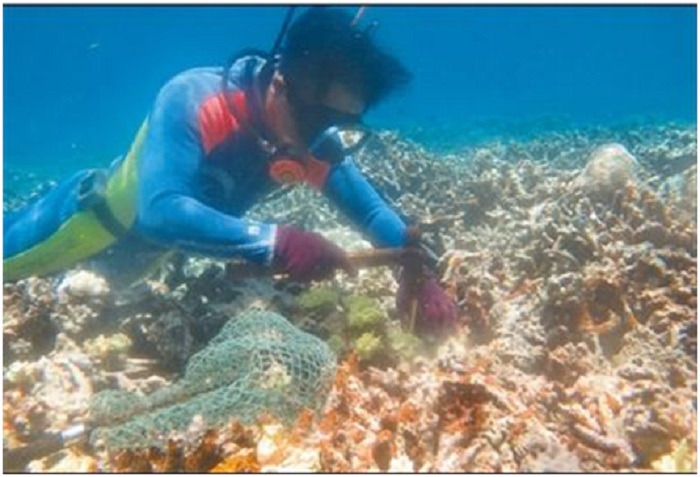



After the rafts arrive at the experiment coral transplantation areas on the sea, researchers put on their diving suits and jump into the sea to “plant” corals on the seabed.
The scene described above is part of the daily routine of a group of coral cultivation researchers at Hainan South China Sea Institute of Tropical Ocean (HITO), a non-profit provincial-level scientific research institution in south China’s Hainan province.
On a sea-based experimental platform, a HITO research team led by Chen Hong, head of HITO, breaks the collected corals into smaller pieces and ties them onto the seedbeds. These seedbeds with “coral seedlings” will then be “planted” on the seabed.
Conducting experiments during the day and doing research at night, coral cultivation researchers at HITO determine to build a coral garden on the seafloor.
Today, vast stretches of colorful corals are thriving in the sea area west of the Fenghuang Island in Sanya, Hainan province. Ten years ago, however, there were only a small number of coral reefs and hardly living corals in the west side of the island.
On June 8, 2011, the Fenghuang Island coral reef ecological restoration project was officially launched.
Under the support of the former maritime and fishery bureau of Sanya, the HITO research team tentatively dropped an artificial coral reef weighing about 250 kilograms into the sea water west of the Fenghuang Island, with stony coral seedlings cultivated that year on it.
Problems emerged as soon as the experiment started, according to Chen.
Before the Fenghuang Island was built, stony corals could naturally grow five to six meters deep into the sea.
However, corals were rarely seen below four meters under the seawater in the experimental coral transplantation areas, and the few remaining corals were mainly in shallow water at a depth of around two meters.
After investigation, the HITO research team found that new coral seedlings couldn’t survive in areas below four meters underwater, as these areas have less hydrodynamic force, more sediment, and less transparency.
Based on these findings, the research team quickly adjusted its experiment plan.
“Planting” corals on the seafloor is a task filled with uncertainties and risks. The nascent coral seedlings could be wiped out by violent waves in case of a typhoon.
The researchers couldn’t see below one meter under the water in the experimental coral transplantation sea areas, Chen noted. He said that he once got entangled in waste fishing net during a task in the sea, and was only able to get away with it with the help of his companions.
Hardships and dangers were often followed by happy surprises, according to Chen.
“We discovered that when coral seedlings are injured, they will form calluses and produce a great number of polyps, which could evolve into corallums,” Chen said, adding that the finding provided important inspiration for the research on asexual propagation techniques for corals.
Four to seven new buds often appear around a polyp, Chen pointed out, explaining that these buds would gradually develop into coral seedlings, significantly increasing the reproductive rate and yield of corals.
In 2016, some corals were destroyed by typhoons. Therefore, the HITO re-cultivated 40,000 coral seedlings through asexual propagation techniques and basically formed a coral reef of 1,500 square meters.
According to the research team, the survival rate of the batch of coral seedlings planted in 2016 exceeded 95 percent.
One year later, the institute cultivated another 101,300 coral seedlings in the sea area near the Fenghuang Island.
In the sea area near Sanya’s Yazhou Bay, 30,000 red gorgonian seedlings have survived, while the 10,000 special local Porites coral seedlings are growing well.
From 2013 to 2020, the HITO research team has also created large coral “gardens” in the sea areas between Yagong Island and Quanfu Island in Hainan’s Sansha city.
The team has accumulatively cultivated a total of 230,000 coral seedlings in the sea in the past nearly ten years.
The fruitful results of coral research and trial coral planting couldn’t have been achieved without relevant experimental platforms.
Early in 1996, Chen built a platform for cultivation of corals on a lagoon in Xincun township, Lingshui Li autonomous county of Hainan.
In 2018, a new experimental platform for coral breeding was established in the sea area near Yazhou Bay by the HITO. The platform is a wooden floating platform covering an area of 120 square meters, and is equipped with four special cages for high-density stereoscopic breeding.
The platform has guaranteed good water quality, which helps avoid high cost of building onshore breeding workshops, said Lv Hongsheng, leader of the cultivation group of the HITO research team.
“It is also equipped with solar power system and labs, so we can make full use of sunlight and reduce consumption of energy in the breeding workshops,” Lv added.
Corals and their symbiotes can fully enjoy natural environment on sea-based platforms, which offer a better environment for their growth than that in indoor breeding facilities.
“In the future, coral gardens will feature integrated ecosystems that can serve as tourism resources, help with environmental protection, and facilitate scientific research,” Chen said, adding that the HITO research team is going to gradually establish information bank for relevant species and artificial propagation systems for corals and their symbiotes.


The Humanitarian Service Diamond Awards has.
A Chinese Company, Inner Galaxy Steel.


The Programme Coordinator, Regulatory, Compliance and.


A Non-Governmental Organization (NGO), Committee for.
The Trustfund Pensions Limited has chided.


The House of Representatives Committee on.
The China General Chamber of Commerce.


Senator Chuka Utazi who represented Enugu.


An Abuja based Legal Practitioner, Ugochukwu.


The African business community in Yiwu,.
Leave a Comment